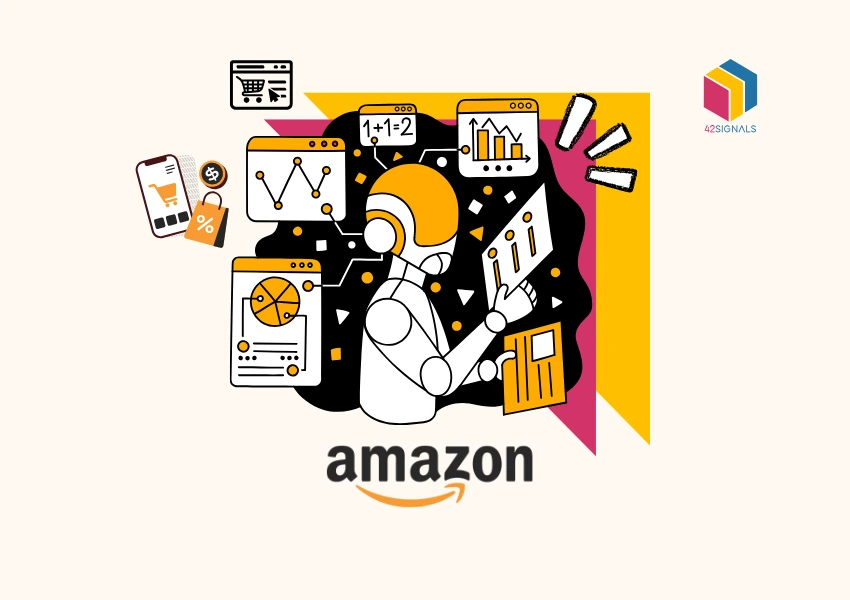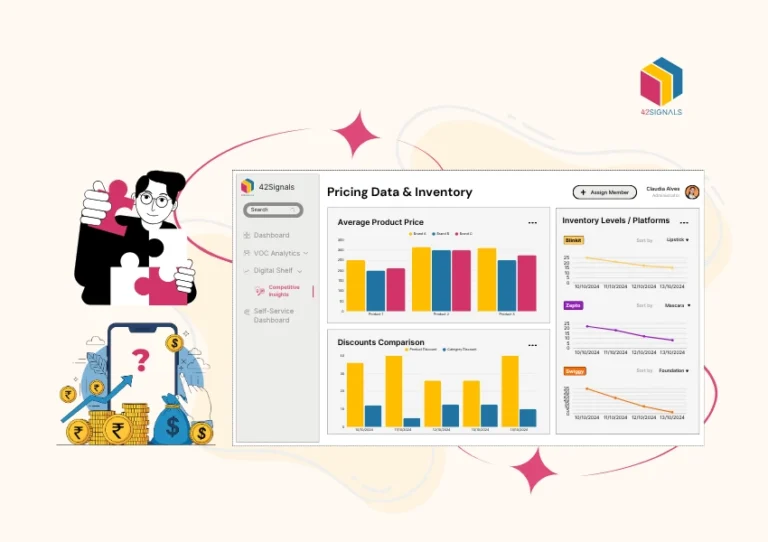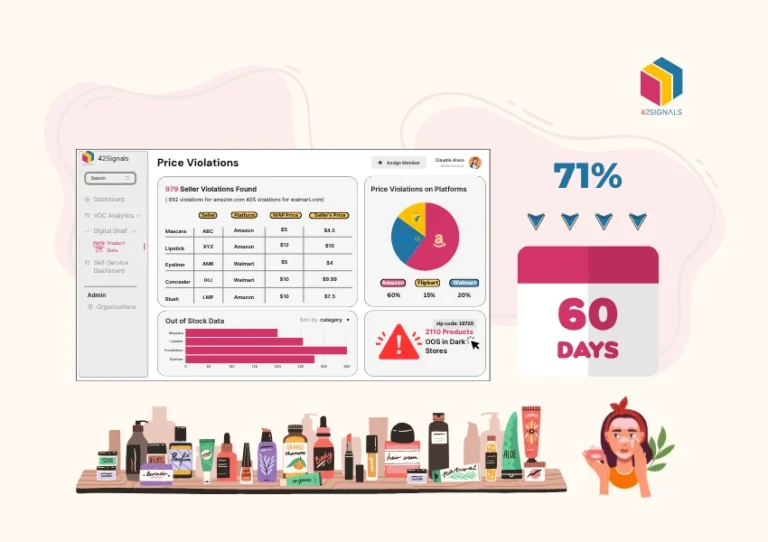Table of Contents
ToggleCracking Amazon’s algorithm isn’t about luck—it’s about understanding the invisible rules that dictate which products win the Buy Box, dominate search results, and convert browsers into buyers. With over 12 million products on Amazon and 2.5 billion monthly visits, standing out requires a blend of understanding the Amazon algorithm and focusing on search ranking factors.
In this guide, we’ll decode how to leverage ecommerce analytics and marketplace visibility tactics to outrank competitors and turn your product into a bestseller.
How the Amazon Algorithm Works (And Why It’s Not Just About Keywords)

Image Source: Seller Engine
Amazon’s A10 algorithm is fundamentally a customer-obsession engine. Its core mission is simple: show shoppers products they are most likely to buy right now, maximizing both customer satisfaction and Amazon’s revenue. While keywords are the entry point, they are merely the starting pistol in a race won by performance and relevance. The algorithm dynamically weighs:
- Relevance: Does the product match the searcher’s intent? (Keywords, attributes, category).
- Performance: Does this product convert browsers into buyers and satisfy them post-purchase?
- Conversion Rate: The ultimate signal of relevance. High CVR proves your listing effectively convinces shoppers.
- Customer Satisfaction: Measured through reviews (rating & volume), return rates, seller feedback, and response times to customer inquiries. Poor satisfaction penalizes rankings heavily.
- Sales Velocity: Consistent, recent sales are the strongest indicator of product desirability and trust. Amazon prioritizes “what’s hot.”
- Click-Through Rate (CTR): How often your product is clicked when shown. High CTR signals compelling imagery/titles.
- Advertising Performance: Well-performing Sponsored Products ads signal relevance and can boost organic ranking.
- Stock Availability: Out-of-stock products disappear. Consistent availability is non-negotiable.
Think of it like this: Amazon wants the surest bet for every search query. Your job is to prove your product is the best through demonstrable customer value and frictionless conversion. Let’s break down how to master this system.
Step 1: Master Amazon SEO with Keyword Optimization
Amazon Algorithm and SEO start with aligning your product listings with what shoppers are searching for. Here’s how to do it right:
A. Reverse-Engineer High-Intent Keywords
- Go Beyond Volume: Use tools like Helium 10, Jungle Scout, or Semrush to find keywords with high purchase intent (e.g., “buy wireless headphones,” “best running shoes for flat feet,” “organic baby shampoo reviews”). Prioritize these over purely informational terms.
- Uncover the “Why”: Analyze top-ranking listings for your target keywords. What specific problems do they solve? What features are emphasized? This reveals the underlying intent.
- Leverage Amazon’s Own Data: Use Search Term Reports (from Sponsored Ads) to see exact phrases shoppers used before clicking your ad. Goldmine for high-intent, converting keywords.
- Long-Tail is King (for Discovery): While competitive head terms drive volume, long-tail phrases like “durable laptop backpack for 17-inch gaming laptop” capture specific needs with less competition and higher conversion potential.
B. Optimize Titles, Bullets, and Backend Fields for the Amazon Algorithm
- Titles: Front-load the absolute core keywords (Brand + Key Product + Key Differentiation). Natural readability is crucial for CTR. (e.g., “Sony WH-1000XM5 Wireless Noise Cancelling Headphones – 30hr Battery, Alexa Built-in”).
- Bullet Points: Don’t just list features; translate them into customer benefits using secondary keywords naturally. Address specific pain points uncovered in reviews/intent research (e.g., “All-Day Comfort: Ultra-soft earcups prevent fatigue, perfect for long flights or work sessions”).
- Product Description & A+ Content: This is where semantic richness shines. Use natural language variations, synonyms, and contextually related terms. Tell a story about use cases and benefits. A+ Content is prime real estate for convincing imagery and deeper explanations.
- Backend Keywords: Maximize the hidden fields with relevant synonyms, common misspellings, acronyms, and closely related terms not used elsewhere. Crucially: Avoid repetition, irrelevant terms, and brand names you don’t own. Amazon does use this data.
- Case Study – Intent Wins: A coffee brand targeting “organic coffee” struggled. Research revealed high intent searches for “low acid organic coffee for sensitive stomach.” They optimized titles, bullets, and A+ Content around stomach-friendly benefits and “low acidity.” Ranking for the long-tail phrase surged, and conversions increased 80% as they matched a specific, high-pain-point intent.
Step 2: Boost Marketplace Visibility with Conversion Rate Optimization
Marketplace visibility means nothing if shoppers don’t convert. Use these tactics:
A. Optimize Images for Instant Trust
- Lifestyle Context: Show the product solving a problem or enabling an aspiration (e.g., family enjoying a picnic using the cooler, someone effortlessly cleaning with the vacuum).
- Infographics: Highlight key specs, materials (e.g., “BPA-Free,” “Hypoallergenic”), and unique features visually for quick scanning.
- Scale & Detail: Include images showing the product in-hand, close-ups of materials/texture, and size comparisons.
- Video is Non-Negotiable: Demonstrate usage, setup, and key features. Videos significantly reduce purchase hesitation. Show the product in action.
B. Weaponize Reviews and Q&A
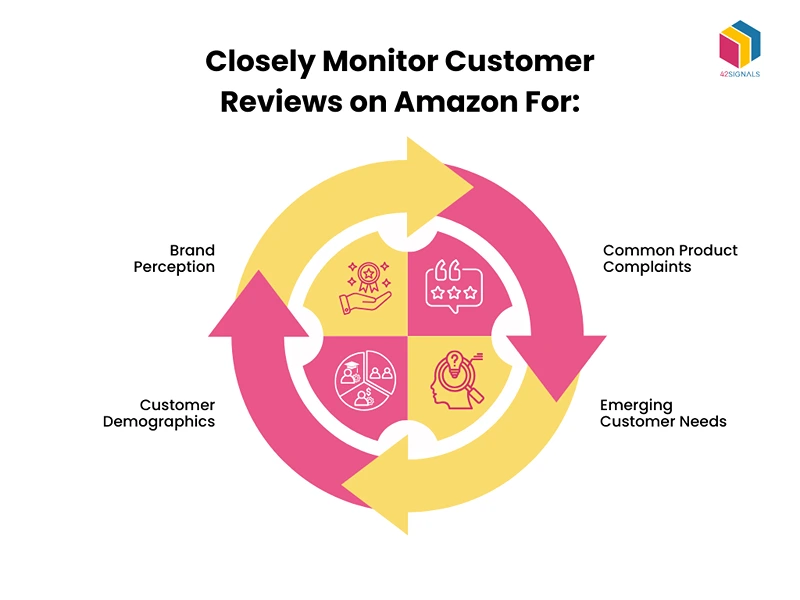
- Proactive Review Generation: Use Amazon’s “Request a Review” button strategically post-delivery. Ethical follow-up emails (via Brand Registry messaging) can gently encourage reviews. Never incentivize positive reviews.
- Aggressively Manage Negative Feedback: Respond professionally and publicly to critical reviews, showing you care and take action. Address valid concerns within the listing (e.g., update bullets for clarity, add an infographic explaining a feature). Use VOC tools like 42Signals to proactively identify emerging negative sentiment trends before they tank your rating and ranking.
- Dominate Q&A: Answer every question quickly and thoroughly. Treat unanswered questions as conversion killers. Incorporate common Q&A insights directly into your bullet points or A+ Content. (“Fits most 10-13 inch tablets – see sizing guide in images!”).
- Use voice of customer analytics tools like 42Signals to understand postive and negative customer sentiment and use that data to fix the overall ratings of the product proactively.
C. Price Competitively (But Profitably) for the Amazon Algorithm
- Use ecommerce analytics tools like 42Signals to track competitors’ pricing
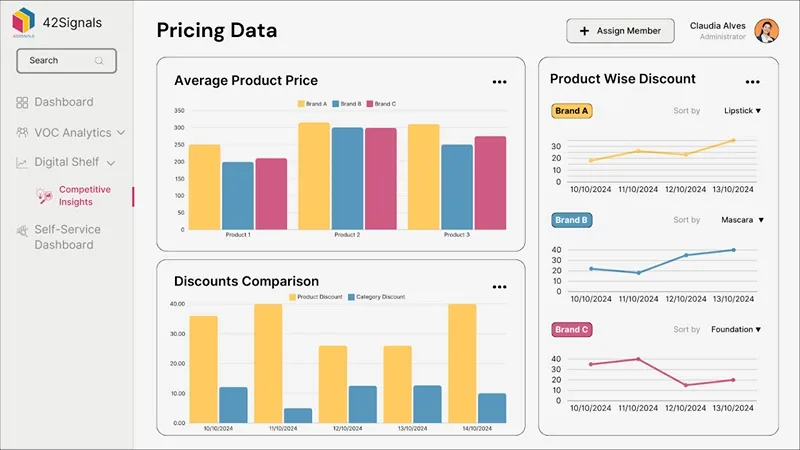
- Justify Your Price: If priced higher, demonstrate superior value through premium content (A+ showcasing better materials, included accessories, superior warranty), stronger reviews, or unique features. Bundle offers can enhance perceived value.
- Leverage Promotions: Strategic use of Coupons and percentage-off deals can boost conversion velocity without permanently lowering your price.
Step 3: Dominate Search Ranking Factors Beyond Keywords
Amazon’s search ranking factors extend far beyond keywords. Focus on these often-overlooked levers:
A. Sales Velocity
- Consistency is Key: Erratic sales hurt. Aim for steady daily sales volume. Limited-time promotions (Lightning Deals if eligible, Coupons) can create powerful spikes that boost ranking, but ensure you can maintain some momentum afterward.
- Leverage External Traffic: Drive targeted traffic from social media, email lists, or your website using Amazon Attribution links. Sales driven from external sources still count as velocity and signal popularity to Amazon.
- “Newer Model” Badge: If you have a genuine upgrade, use this badge effectively. It signals freshness and relevance.
B. Inventory Management for Amazon Algorithm
- Stockouts tank rankings. Set up inventory alerts to replenish before hitting 20% stock.
- Use FBA (Fulfillment by Amazon) for faster shipping and better Buy Box eligibility.
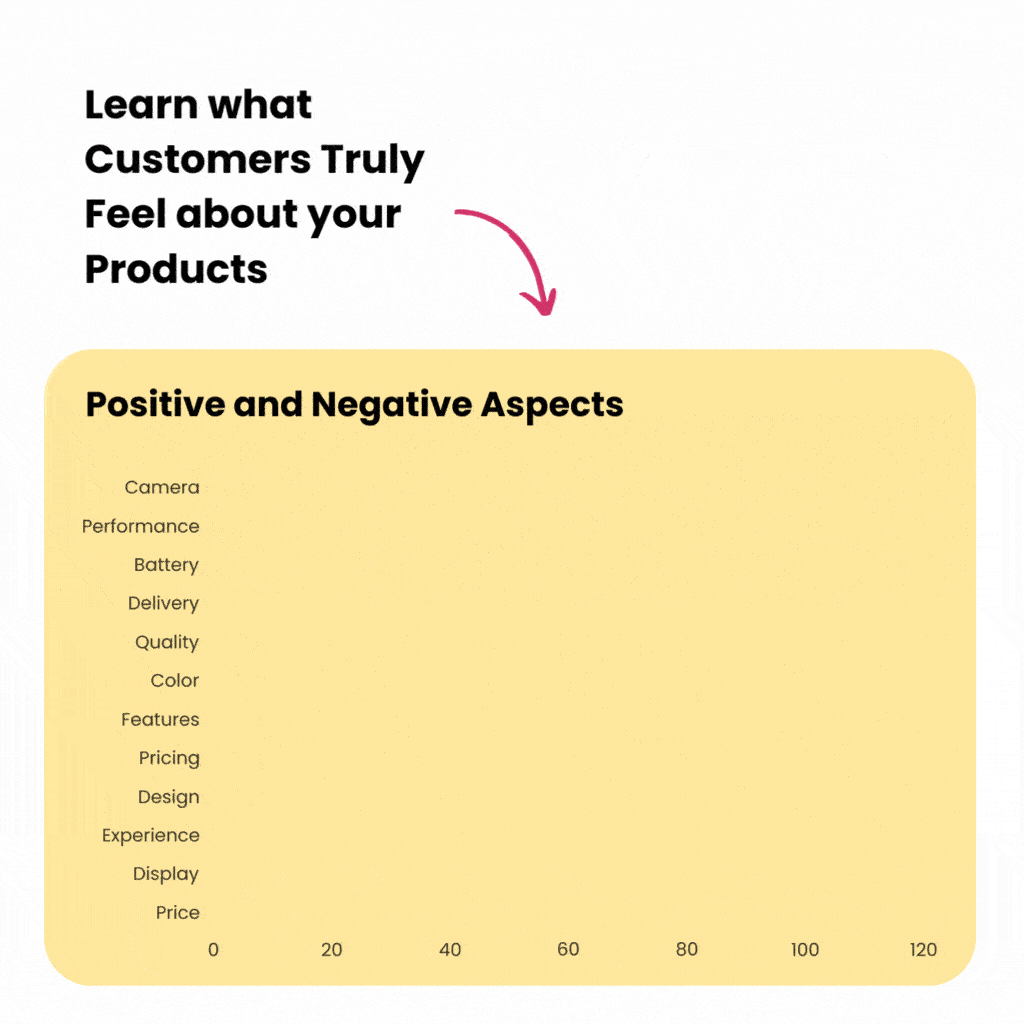
C. Click-Through Rate (CTR)
- A/B Test Your Main Image Relentlessly: Test different backgrounds, models, use-cases, and graphic treatments. What looks compelling to you might not resonate with shoppers. Amazon’s Manage Your Experiments (MYE) tool is built for this.
- Sponsored Brands for Brand Defense & Conquesting: Use Sponsored Brands ads not just for visibility, but to protect your brand name from competitors and strategically bid on competitor brand keywords if you offer a compelling alternative (e.g., “Like [Competitor Brand]? Try [Your Brand] for [Key Benefit]”). High CTR on these ads signals relevance.
Pro Tip:
Tools like Sellics or Teikametrics provide holistic dashboards to track CTR, conversion rates, and inventory health in one place.
Step 4: Leverage Ecommerce Analytics to Spy on Competitors
Ecommerce analytics tools like 42Signals let you:
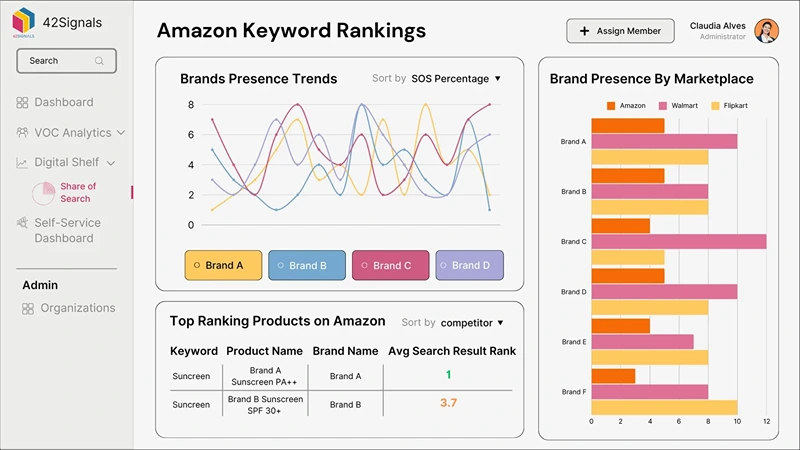
- Keyword Gap Analysis: Discover high-performing keywords your competitors rank for that you’re missing. Reverse-engineer their keyword strategy.
- Pricing & Promotion Alerts: Get notified instantly when competitors drop prices or launch promotions, allowing rapid response.
- Review Sentiment Tracking: Don’t just see competitor ratings; analyze their review content. What are their consistent strengths (to counter or match) and weaknesses (to exploit)? Identify emerging complaints before they become crises for them.
- Share of Voice (SOV) Tracking: Understand how often your brand/products appear in search results vs. key competitors for critical terms. Measure your market visibility.
- Benchmarking: Compare your vital stats (CVR, Session %, Review Rating, Review Velocity, Price) against category leaders and averages. Identify your weakest performance pillars.
Example – Turning Data into Dominance: An electronics accessory seller used 42Signals to see a competitor dominating “fast charging car mount.” Analysis revealed their A+ Content heavily featured a specific safety certification. The seller obtained the same certification, highlighted it prominently in their title and images, and emphasized “Safety Certified Fast Charging” in ads. They captured a significant market share within 60 days by addressing a key perceived differentiator.
Example:
A skincare brand noticed a competitor’s serum consistently ranked #1 for “anti-aging vitamin C.” By analyzing their listings, they discovered the rival used customer reviews in A+ Content (e.g., “90% saw brighter skin in 2 weeks”). The brand replicated this tactic and saw a 40% CTR boost.
Step 5: Avoid These Amazon Algorithm Killers
- Ignoring Negative Reviews & Sentiment: Negative reviews directly impact conversion rates and customer satisfaction scores – core ranking factors. Use 42Signals sentiment analysis to spot trends (e.g., multiple complaints about battery life) and address the root cause in the product or listing. A single scathing review might be an outlier; a pattern is an algorithm penalty waiting to happen.
- Keyword Stuffing & Black-Hat Tactics: Stuffing titles or backend keywords with irrelevant terms triggers spam filters and degrades readability (hurting CTR/CVR). Avoid fake reviews, review manipulation, or incentivized reviews – Amazon’s AI detects these with increasing sophistication, leading to suspensions.
- Inconsistent Sales Velocity & Stockouts: Erratic sales signal instability. Stockouts reset your sales history momentum. Both tell the algorithm your product is unreliable. Plan promotions and inventory meticulously.
- Poor Image/Video Quality: Blurry, unprofessional, or uninformative visuals destroy CTR and CVR. Invest in high-quality, benefit-driven creatives.
- Slow Customer Response Times: Failing to answer buyer messages or Q&A promptly negatively impacts seller metrics and customer satisfaction, indirectly harming ranking. Automate where possible, but prioritize timely, helpful responses.
- Ignoring Advertising Performance: Poorly performing Sponsored Ads (low CTR, low CVR, high ACOS without a strategic goal like launching a new product) can signal low relevance to Amazon, potentially impacting organic perception. Optimize campaigns continuously.
The Future of Amazon SEO: AI and Personalization
Amazon is doubling down on AI-driven search:
- Voice Search Optimization: Shoppers use phrases like “Alexa, find affordable running shoes.” Target conversational keywords.
- Visual Search: Tools like StyleSnap let users upload photos to find similar products. Optimize images for color, texture, and context.
Your Next Move:
Test one AI-powered tool (e.g., Perpetua for automated ad optimization) to stay ahead of algorithm updates.
Final Word: Think Like the Algorithm
Cracking Amazon’s algorithm isn’t about gaming the system—it’s about aligning with what Amazon values most: customer satisfaction and sales efficiency.
As the algorithm is constantly evolving, a few steps remain consistent to ensure better rankings and visibility on the platform –
- Good product descriptions that include the right keywords and long-tail keywords
- Great images showcasing the product’s dimensions, usability, and functionality
- Granular ecommerce analytics tools like 42Signals help you with everything else, like competitor intelligence and category insights
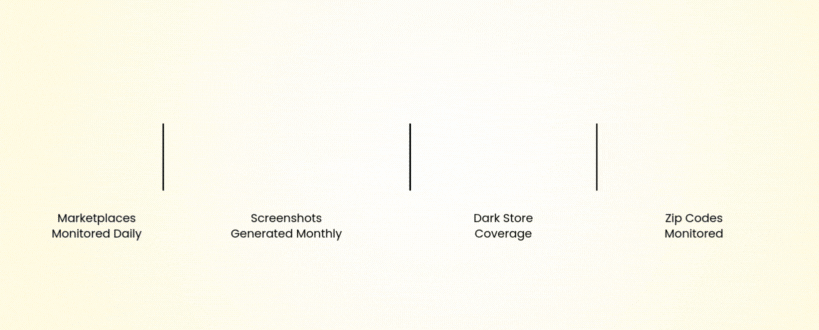
Act Now:
Audit your top-performing competitor’s listing today. Steal one keyword or tactic they’re using, and implement it by tomorrow.
42Signals helps ecommerce businesses in this arena understand what’s going on for a brand’s products as well as competitor strategies.
Sign up for a free trial to see the platform in action for your brand and products.
Frequently Asked Questions About Amazon Algorithm
What is Amazon’s algorithm?
Amazon’s main algorithm, known as the A9 algorithm, powers its product search engine. It determines how products are ranked and displayed when a customer searches for something. The algorithm considers multiple factors, such as:
- Relevance to the search query (based on product title, description, and keywords)
- Sales history and performance
- Customer reviews and ratings
- Price and availability
- Fulfillment method (e.g., FBA gets preference)
The goal of Amazon’s algorithm is to show shoppers the products they’re most likely to buy, based on both product quality and buyer intent.
What is the Amazon Choice algorithm?
The Amazon’s Choice badge is awarded to products that meet a combination of performance, quality, and relevancy standards. While the exact algorithm isn’t publicly disclosed, it’s believed to factor in:
- High customer ratings
- Fast shipping options (especially Prime-eligible)
- Competitive pricing
- Low return rates
- Strong conversion rates for specific search terms
It’s designed to help shoppers make quick purchase decisions, especially through voice search or mobile shopping.
What is the Amazon recommender algorithm?
Amazon’s recommender system is a personalized algorithm that suggests products to users based on their behavior and preferences. It powers features like:
- “Customers who bought this also bought…”
- “Frequently bought together”
- Product carousels on the homepage or category pages
This algorithm uses a mix of collaborative filtering (comparing user behavior) and content-based filtering (matching products with similar attributes) to drive engagement and increase average order value.
What is the AMZ algorithm?
“AMZ algorithm” is often a shorthand term sellers or marketers use to refer broadly to Amazon’s various algorithms, including:
- A9 (search ranking)
- Buy Box algorithm (which decides who wins the Buy Box)
- Pricing and repricing algorithms
- Recommendation engines
Each plays a role in how visibility, conversions, and seller performance are managed on the platform. Understanding these algorithms is key for sellers looking to optimize product listings, pricing, and marketing strategies on Amazon.
